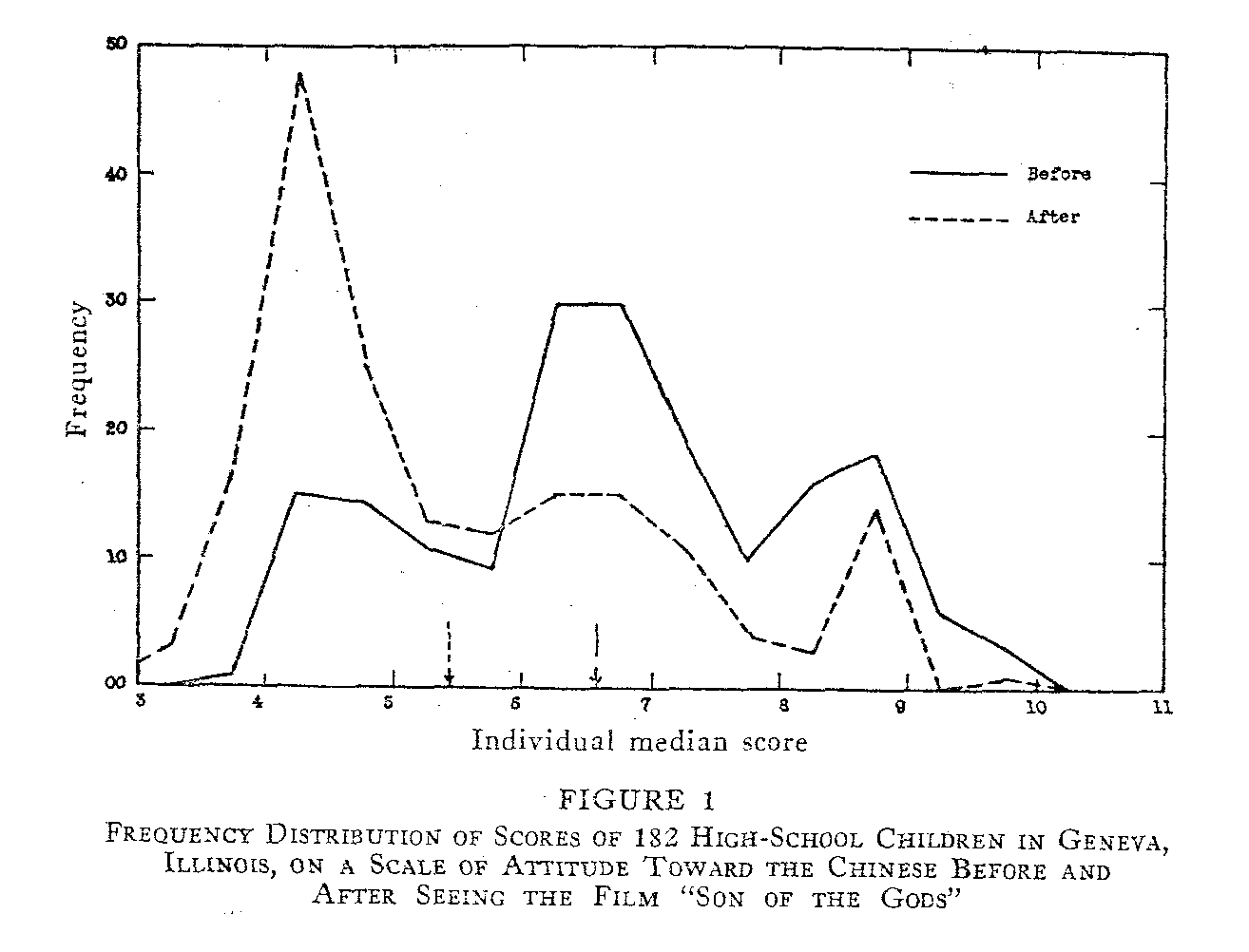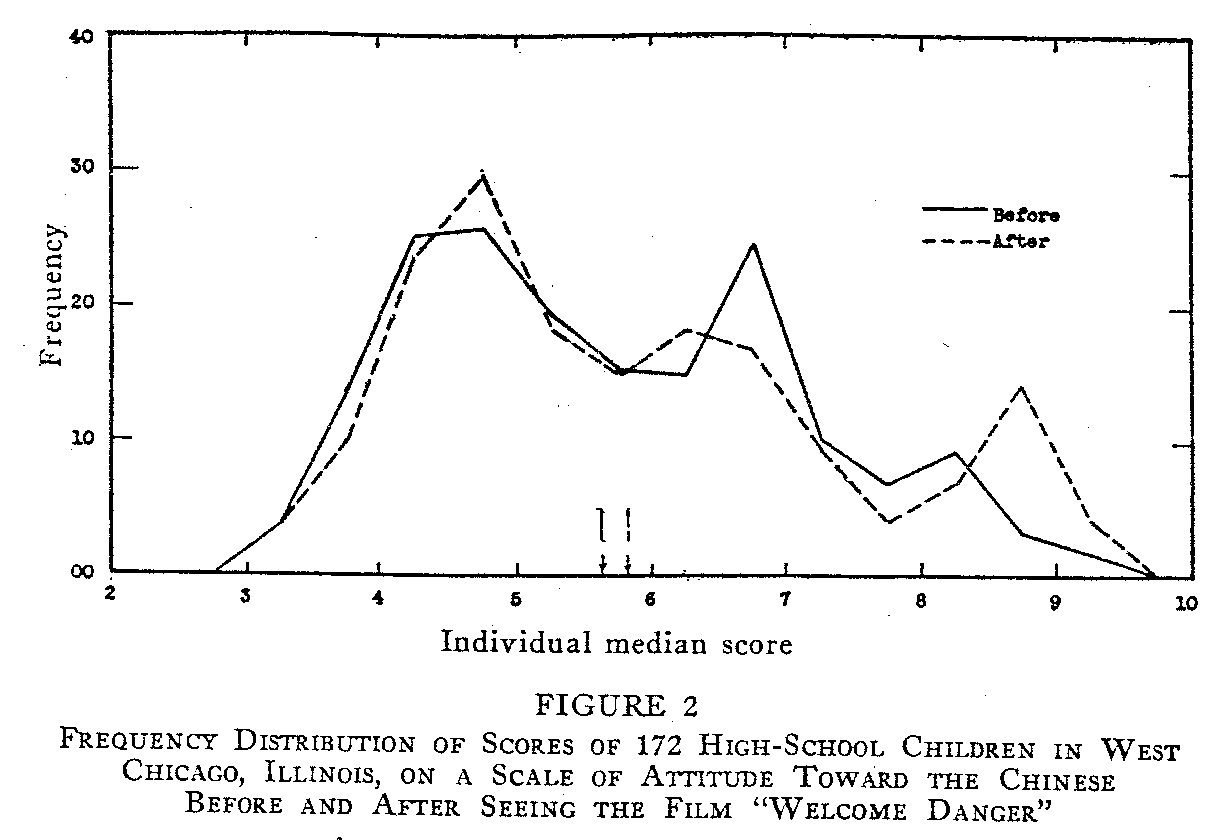The Measurement of Change in Social Attitude
Louis L. Thurstone
The experiment to be described in this paper was set up in order to ascertain whether the effect of a single motion picture on the social attitudes of school children could be measured by an attitude scale in the' statement form. The plan was, in brief, to let the school children of one town see a film favorable to Chinese culture and in a second town the school children were shown a film that has been criticized as unfriendly to the Chinese. Before and after seeing the film in their respective, towns, the children filled in a statement scale about the Chinese. The results show that the attitudes of the children were changed in opposite directions in the two towns, thus demonstrating the effect of the films as well as verifying the methods used.
The two towns selected for the experiments were Geneva, Illinois, and West Chicago, Illinois. The relevant facts about these two towns are given in Table 1. The film "Son of the Gods" has been considered rather friendly in its interpretation of Chinese culture. It was shown in Geneva, Illinois. One week before and the day after seeing this picture, the children filled in a statement scale about the Chinese. This attitude scale was constructed by the method of equal appearing intervals. The scale value of each statement is recorded for each opinion in the list. It was constructed by the pooled judgments of 30 subjects. Since the detailed methods of constructing an attitude scale have been described elsewhere (1), they will not be repeated here.
In Figure 1 we have the frequency distribution of attitudes of these children to the Chinese as determined on May 19, 1930,. before they saw the picture. The picture was shown in the local theater by special arrangement on May 26, 1930. On the morning after seeing the picture, the children again filled in the statement scale about the Chinese. They had been told
( 231)

previously that the scale was to be filled in twice several days apart. In Figure 1 we have shown also the frequency distribution of their attitudes toward the Chinese after seeing the film. The shift in attitude as a result of the picture is striking. The picture evidently made the children more friendly toward the Chinese. The statistical facts about the two frequency distributions are as follows:
Number of children 182
Mean attitude score (before) 6.63
Mean attitude score (after) 5.45
Standard deviation of scores (before) 1.46
Standard deviation of scores (after) 1.54
Correlation between the two sets of scores + .57
Ratio of the difference to the probable error of
the difference 16.98
We are undoubtedly justified in concluding that the film "Son of the Gods" has the effect of making the children more friendly toward the Chinese. It is of some interest to establish that the effect of a single film on the social attitudes of children can be measured by a statement scale.
( 232)

(233)

It is more difficult to find films that are antagonistic to foreign nationalities than to find films that are, on the whole, friendly toward foreign cultures. The film "Welcome Danger" has been criticized by the Chinese for its unfriendly manner of dealing with the Chinese and it was therefore selected for this experiment. The film was shown in West Chicago. One week before and the day after seeing the picture, the children filled in the same scale about the Chinese that was used in Geneva. The two frequency distributions, before and after, are shown in Figure 2. Here there is evident a slight shift in the opposite direction. The statistical facts about the two frequency distributions are as follows:
Number of children 172
Mean attitude (before) 5.66
Mean attitude (after) 5.81
Standard deviation (before) 1.42
Standard deviation (after) 1.56
Correlation between two sets of attitude scores+ .58
Ratio of the difference to the probable error of
the difference 2.22
It is evident that the film "Welcome Danger" made the children some-what more unfriendly toward the Chinese, although the effect of this film against the Chinese was by no means so marked as the effect of the previous film favorable to the Chinese. It would be interesting to compare the
( 234) relative ease of moving an audience in the favorable and in the unfavorable directions about a foreign country or race. Unfortunately, that cannot be done experimentally unless the appeal of the two stimuli can be equated by criteria other than their measured effect on the audience.
The present experiments show experimentally that a single film has a measurable effect on the international attitudes of school children and that these effects can be measured by a statement scale.
The statement scale about the Chinese contained the following instructions and opinions. The scale value is recorded for each opinion in the following list. The attitude score is the median scale value of all the opinions endorsed by the subject. The scale values a-re not printed on the blanks given to the subjects.
This is a study of attitudes toward the Chinese. On the other side of this page you will find a number of statements expressing different attitudes toward the Chinese.
√ Put a check mark if you agree with the statement.
X Put a cross if you disagree with the statement.
Try to indicate either agreement or disagreement for each statement. If you simply cannot decide about a statement you may mark it with a question mark.
This is not an examination. There are no right or wrong answers to these statements. This is simply a study of people's attitudes toward the Chinese. Please indicate your own convictions by a check mark when you agree and by a cross when you disagree.
√ Put a check mark if you agree with the statement.
X Put a cross if you disagree with the statement.
Scale value
6.5 1. I have no particular love nor hate for the Chinese.
10.1 2. I dislike the Chinese more every time I see one.
4.7 3. The Chinese are pretty decent.
7.2 4. Some Chinese traits are admirable but on the whole I don't like them.
.5 5. The Chinese are superior to all other races.
8.7 6. The Chinese as part of the yellow race are inferior to the white race.
3.5 7. I like the Chinese.
2.8 8. The more I know about the Chinese the better I like them.
11.0 9. The Chinese are aptly described by the term "yellow devils."
1.8 10. The high class Chinese are superior to us.
5.2 11. The Chinese are different but not inferior.
11.5 12. I hate the Chinese.
4.1 13. Chinese parents are unusually devoted to their children.
7.7 14. Although I respect some of their qualities, I could never consider a Chinese as my friend.
1.2 15. I would rather live in China than any other place in the world.
( 235)
9.7 16. There are no refined nor cultured Chinese.
6.0 17. The Chinese are no better and no worse than any other people.
8.4 18. I think. Chinese should be kept out of the United States,
2.2 19. I consider it a privilege to associate with Chinese people.
10.6 20. The Chinese are inferior in every way.
9.4 21 I don't see how anyone could ever like the Chinese.
3.0 22. Chinese have a very high sense of honor.
8.6 23. I have no desire to know any Chinese.
1.4 24 Chinese people have a refinement and depth of feeling that you don't find anywhere else.
9.8 25. There is nothing about the Chinese that I like or admire.
3.9 26 I'd like to know more Chinese people.
REFERENCE
1. THURSTONE, L. L., & CHAVE, E. J. The measurement of
attitude. Chicago: Univ. Chicago Press, 1929. Pp. 96.
University of Chicago
Chicago, Illinois